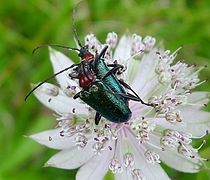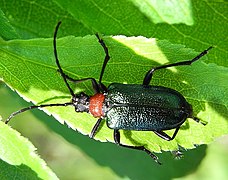Gaurotes virginea
| Gaurotes virginea | |
|---|---|

| |
| Gaurotes virginea thalassina | |
| Scientific classification | |
| Kingdom: | |
| Phylum: | |
| Class: | |
| Order: | Coleoptera |
| Suborder: | |
| Superfamily: | Cerambycoidea |
| Family: | Cerambycidae |
| Subfamily: | |
| Genus: | |
| Species: | G. virginea
|
| Binomial name | |
| Gaurotes virginea | |
| Synonyms | |
| |
Gaurotes virginea is a species of the
Subtaxa
There are four varietets in species, and four varietets in nominative subspecies:[1]
- Gaurotes virginea aemula Mannerheim, 1852
- Gaurotes virginea kozhevnikovi Plavilstshikov, 1915
- Gaurotes virginea thalassina (Schrank, 1781)
- Gaurotes virginea virginea (Linnaeus, 1758)
- Gaurotes virginea virginea var. notaticollis (Pic)
- Gaurotes virginea virginea var. sanguinaria (Pic)
- Gaurotes virginea virginea var. vidua (Mulsant, 1839)
- Gaurotes virginea virginea var. violacea (DeGeer)
Distribution and habitat
This beetle is distributed in most of Europe (Austria, Belgium, Czech Republic, France, Germany, Italy, Luxembourg, Norway, Poland, Romania, Slovakia, Slovenia, Sweden, Switzerland) and in the eastern Palearctic realm (Russia, Kazakhstan, China, Mongolia, and Korea).[1][2] They inhabit spruce forests. They are very common and frequent along the alpine arc.[3]
Description
Gaurotes virginea has a body length of 7–13 millimetres (0.28–0.51 in).[4][3] These beetles are quite robust, elytra are bright blue with a metallic sheen. Pronotum is black, reddish or black with rusty spots. The abdomen is usually reddish, but some subspecies are characterized by a totally black prothorax and black abdomen.[5]
This species is rather similar to Dinoptera collaris, but G. virginea is bright blue with strong metallic reflections while D. collaris is bright black without metallic reflections. Moreover, the first species shows an obtuse tooth on the sides of the prothorax, while in the second the sides of the prothorax are rounded.
Biology
The life cycle of these beetles lasts two years. Larvae are oligophagous wood borers in coniferous trees, they live under the bark and mainly feed on Scots pine (
Gallery
-
Mating
-
Upperside view
-
Side view
-
Clip
References
- ^ a b c BioLib Taxon profile — species Gaurotes virginea (Linnaeus, 1758)
- ^ Fauna europaea
- ^ a b c Commanster
- ^ a b Longhorn beetles (Cerambycidae) of the West Palearctic region
- ^ Mikhil Leonyyevich Danilevsky & Seung Hwan Oh Carilia virginea komensis (Tamanuki, 1938), stat. nov. from Korea (Coleoptera: Cerambycidae: Lepturinae)
- ^ A. Szujecki Ecology Of Forest Insects



